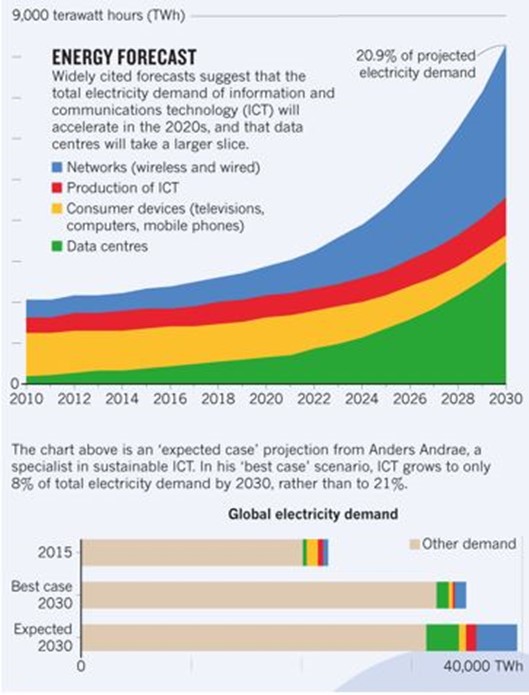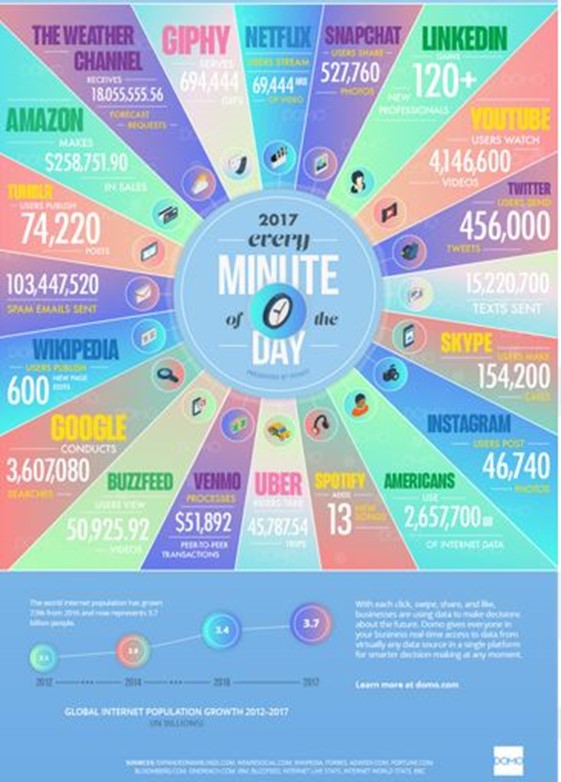Big data: A big energy challenge?
The growth of the global internet population has caused an explosion in online data. In terms of market capitalisation, the five biggest global companies are now Apple, Amazon, Alphabet, Microsoft and Facebook, replacing organisations such as Shell and ExxonMobil.
While computers provide a reduction in net energy consumption at a community level (through decreased transportation, better manufacturing techniques, etc.) increased computer use has led to significant growth in data centres[i] and a trend towards higher density and higher processing power equipment, causing a rise in localised energy consumption and emissions.
Information and Communication Technology (ICT) is fast becoming one of the largest sectors for the consumption of energy, and is now on par with the aviation industry’s carbon emissions from fuel.
Data centres – which are used to house computer systems - are the main driver of this growth and the trend is not looking to slow (Figure 1), sparking Schneider Electric’s global Chairman Jean-Pascal Tricoire to recently say: “The fastest growing energy demand is in IT and these data centres. The amount of power going into data centres now is comparable to a small city. It’s really the start of a new era.”[ii]
Figure 1: ICT energy forecast

Source: Nature: International Journal of Science, Sept 2018
Data centres account for almost 4 per cent of Australia’s total energy consumption and around 10 per cent of the world’s energy consumption[iii]. So what does this mean for the future of data centre energy consumption?
Data explosion
Internet data is being generated and stored at record levels. In the last five years the number of internet users has grown by over one billion. Now, more than 4 billion people – or 52 per cent of the world’s population - use the internet, up 7 per cent year-on-year.
The last two years alone has produced over 90 per cent of the world’s current data[iv] and according to Dozo’s 2017 Data Never Sleeps 5.0 report, more than half of the globe’s online traffic is now coming from mobile smart phones[v] - further driving an increase data generation.
Every Google search, Facebook post, tweet, swipe and Instagram post all need to be powered by data centres. Cloud-based computing and a growing number of websites also require data centre back-up, while this year the number of Australians who watch Netflix is expected to surpass those who watch subscription TV.
Figure 2 illustrates the rate of data generation across the globe for each minute in 2017. While Internet Live Stats shows the growing rate of daily data generation in real time.
Figure 2: Data generated each minute, 2017

Source: Dozo, 2017 Data Never Sleeps 5.0 report
Data centre energy consumption
Data centres consume around an estimated 200 terawatt hours (TWh) annually – more than the energy consumption of some countries (Argentina, Ukraine, Thailand[vi]) half of the electricity used for transport worldwide, and around 1 per cent of global electricity demand. Data centres contribute around 0.3 per cent to overall carbon emissions, while the ITC sector accounts for more than 2 per cent of global emissions[vii].
Data centres are anticipated to grow to consume a fifth of all the world’s energy by 2025, and now have the fastest growing CO2 within the ICT sector due to technological advances such as cloud computing and the rapid growth of the Internet[viii].
And if cryptocurrencies continue to grow, there could be a sharp rise in energy demand. It is estimated that the current global power consumption for the servers that run Bitcoin’s software is a minimum of 2.55 GW (around 22 TWh per year) which is roughly the same as Ireland’s power consumption.
Bitcoin is founded on a blockchain that virtually transfers value from one party to another. While the cryptocurrency’s exchange price is extremely volatile, if it were to stay at its recent price of $8,000 power usage of the network would peak at 7.67 GW (67 TWh per year) or one-fifth of Britain’s energy use[ix] as more processing power is required to mint the virtual coins.
Australia’s challenges
There are now around 50,000 data centres across Australia, and 95 per cent of these are small-scale. Individual centres are custom designed, so when the average Australian centre was initially built in 1994 it was, generally, inefficiently designed. As a data centre grows, its energy consumption increases largely due to the cooling energy required to maintain a controlled temperature environment. According to an IDC Australia report:
“The major challenge faced by data centre managers today is that they lack a comprehensive understanding of their datacentres' energy environment. To operate efficiently, there is a need for visibility into how and where power is being consumed by IT systems across the environment and whether or not there is adequate cooling capacity that is correctly provisioned to the IT loads. Energy efficiency extends beyond the IT systems to the data centre infrastructure in support of those systems. Today, many data centres have over-provisioned or ineffectively provisioned their power and cooling, resulting in stranded power that does not make full use of the data centre capacity, thus creating hotspots that risk system failures.”
With the growing rate of data load, companies are now looking to reduce both costs and emissions by running centres more efficiently. The ageing centres coupled with the cost of electricity is pushing more people to consider colocation – a large scale facility where equipment and space are available for rental. There are currently 107 colocation centres that are classified as ‘enterprise size’ in Australia, and they consume around the same amount of electricity as Coles’ 807 supermarkets and Woolworths' 995 stores[x].
The future
While banning high-definition cameras on phones could reduce data traffic in Europe by 40 per cent, “We can’t put the lid back on Pandora’s Box,” said Ian Bitterlin, UK consulting engineer and data-centre expert, “but we could reduce data-centre power.[xi]”
The ICT sector is now looking at how to increase the energy efficiency of processors and data centres to counter increased internet traffic and data loads – and while more needs to be done, advances are being made[xii]
Intelligent Data Centres can consume up to 80 per cent less energy than traditional designs. In 2016, Metronode’s Australia data centres consumed 40GWh of energy and generated 37kT of CO2 emissions. If the centres were built using traditional technologies, they would have consumed 56GWh of energy with 52kT CO2 emissions.
Some believe that the ICT sector might also give renewables a leg-up. Facebook and Apple have committed to using 100 per cent renewable energy, with other online companies following suit. Google is now the largest corporate purchaser of renewable energy in the world.
[i] http://www.energyrating.gov.au/products/data-centres
[ii] https://www.smh.com.au/business/the-economy/data-centre-power-use-greater-than-woolworths-coles-combined-20180922-p505df.html
[iii] https://www.smh.com.au/business/the-economy/data-centre-power-use-greater-than-woolworths-coles-combined-20180922-p505df.html
[iv] https://www.forbes.com/sites/bernardmarr/2018/05/21/how-much-data-do-we-create-every-day-the-mind-blowing-stats-everyone-should-read/#659ae4ae60ba
[v] https://www.domo.com/learn/data-never-sleeps-5
[vi] https://yearbook.enerdata.net/electricity/electricity-domestic-consumption-data.html
[vii] https://www.nature.com/articles/d41586-018-06610-y
[viii] Trends in Data Centre Energy Consumption under the European Code of Conduct for Data Centre Energy Efficiency: https://www.researchgate.net/publication/319996455_Trends_in_Data_Centre_Energy_Consumption_under_the_European_Code_of_Conduct_for_Data_Centre_Energy_Efficiency [accessed Sep 26 2018].
[ix] https://www.economist.com/the-economist-explains/2018/07/09/why-bitcoin-uses-so-much-energy
[x] https://www.smh.com.au/business/the-economy/data-centre-power-use-greater-than-woolworths-coles-combined-20180922-p505df.html
[xi] https://www.nature.com/articles/d41586-018-06610-y[i]
[xii] The Top 9 mistakes in data center design and planning, https://www.se.com/ww/en/work/campaign/data-center-design-overview/
Related Analysis
2025 Election: A tale of two campaigns
The election has been called and the campaigning has started in earnest. With both major parties proposing a markedly different path to deliver the energy transition and to reach net zero, we take a look at what sits beneath the big headlines and analyse how the current Labor Government is tracking towards its targets, and how a potential future Coalition Government might deliver on their commitments.
Data Centres and Energy Demand – What’s Needed?
The growth in data centres brings with it increased energy demands and as a result the use of power has become the number one issue for their operators globally. Australia is seen as a country that will continue to see growth in data centres and Morgan Stanley Research has taken a detailed look at both the anticipated growth in data centres in Australia and what it might mean for our grid. We take a closer look.
Transmission Access Reform: Has the time passed?
Last week submissions to the AEMC’s Transmission Access Reform consultation paper closed. It is the latest in a long running consideration of how best to ensure both efficient dispatch and investment in new generation to ensure new kit is sited in the best locations. But this continued pursuit of reform brings to the fore the question of whether other policy initiatives have already superseded the need for the proposed changes. We take a look at where the reform proposals have come from, as well as concerns about the suggested approach that have emerged.
Send an email with your question or comment, and include your name and a short message and we'll get back to you shortly.



